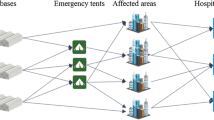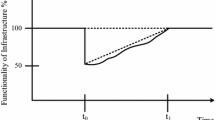Abstract
This paper seeks to enhance network survivability under a disaster and reduce the expected post-disaster response time for transportation networks through pre-disaster investment decisions. The planning focuses on determining the links of the network to strengthen through investment under two types of uncertainties: the disaster characteristics, and the surviving network under each disaster. A bi-level stochastic optimization model is proposed for this problem, in which link investment decisions are made at the upper level to enhance the network survivability subject to a budget constraint such that the expected post-disaster response time is minimized at the lower level. A two-stage heuristic algorithm is proposed to obtain effective solutions efficiently. The numerical experiments indicate that the proposed heuristic algorithm converges to a fixed point representing a feasible solution, within an acceptable tolerance level, of the bi-level stochastic optimization model which is an effective solution under disasters of moderate severity. Parametric and sensitivity analyses reinforce the need for a holistic approach that integrates multiple relevant considerations to determine the link investment decisions.






Similar content being viewed by others
References
Abdel-Rahim A, Oman P, Johnson B, Tung LW (2007) Survivability analysis of large-scale intelligent transportation system networks. Transp Res Rec J Transp Res Board 2022:9–20
Ball MO, Golden BL, Vohra RV (1989) Finding the most vital arcs in a network. Oper Res Lett 8(2):73–76
Bana e Costa CA, Oliveira CS, Vieira V (2008) Prioritization of bridges and tunnels in earthquake risk mitigation using multicriteria decision analysis: application to Lisbon. Omega 36(3):442–450
Baum A, Fleming R, Davidson LM (1983) Natural disaster and technological catastrophe. Environ Behav 15(3):333–354
Chen A, Yang C, Kongsomsaksakul S, Lee M (2007) Network-based accessibility measures for vulnerability analysis of degradable transportation networks. Netw Spat Econ 7(3):241–256
Fan Y, Liu C (2010) Solving stochastic transportation network protection problems using the progressive hedging-based method. Netw Spat Econ 10(2):193–208
Farvaresh H, Sepehri MM (2013) A branch and bound algorithm for bi-level discrete network design problem. Netw Spat Econ 13(1):67–106
Grotschel M, Monma CL, Stoer M (1995) Design of survivable networks. Handbook in operations research and management science: network models 7. North-Holland, Amsterdam, pp 617–672
Holguín-Veras J, Hart WH, Jaller M, Van Wassenhove LN, Pérez N, Wachtendorf T (2012) On the unique features of post-disaster humanitarian logistics. J Oper Manag 30(7–8):494–506
Hsu Y-T, Peeta S (2013) Clearance time estimation for incorporating risk in strategies for evacuation operations. Netw Spat Econ. doi:10.1007/s11067-013-9195-5
Hwang H, Jernigan JB, Lin YW (2000) Evaluation of seismic damage to Memphis bridges and highway systems. J Bridg Eng 5(4):322–330
Jeroslow RG (1985) The polynomial hierarchy and a simple model for competitive analysis. Math Program 32(2):146–164
Kerivin H, Mahjoub AR (2005) Design of survivable networks: a survey. Networks 46(1):1–21
Kiremidjian AS, Moore J, Basoz N, Burnell K, Fan Y, Hortacsu A (2002) Earthquake risk assessment for transportation systems: analysis of pre-retrofitted system. Proceedings of the 7th National Conference on Earthquake Engineering, EERI, Boston, pp 2109–2116
Latora V, Marchiori V (2005) Vulnerability and protection of infrastructure networks. Phys Rev E 71(1):015103R
Liu CZ, Fan YY, Ordonez F (2009) A two-stage stochastic programming model for transportation network retrofit. Comput Oper Res 36(5):1582–1590
Loh CH, Lee CY, Yeh CH (2003) Seismic risk assessment of transportation system: evaluation immediately after earthquake. Advancing Mitigation Technologies and Disaster Response for Lifeline Systems, ASCE: 123–132
Malik K, Mittal AK, Gupta SK (1989) The k most vital arcs in the shortest path problem. Oper Res Lett 8(4):223–227
Matisziw TC, Murray AT (2009) Modeling s-t path availability to support disaster vulnerability assessment of network infrastructure. Comput Oper Res 36(1):16–26
Matisziw TC, Murray AT, Grubesic TH (2010) Strategic network restoration. Netw Spat Econ 10(3):345–361
Moghtaderi-Zadeh M, Der Kiureghian A (1983) Reliability upgrading of lifeline networks for post-earthquake serviceability. Earthq Eng Struct Dyn 11(4):557–566
Murray-Tuite PM, Mahmassani HS (2004) Methodology for determining vulnerable links in a transportation network. Transp Res Rec J Transp Res Board 1822:88–96
Nagurney A, Qiang Q (2007) A network efficiency measure for congested networks. Europhys Lett 79(3):1–5
Peeta S, Salman FS, Gunnec D, Viswanath K (2010) Pre-disaster investment decisions for strengthening a highway network. Comput Oper Res 37:1708–1719
Porter K, Ramer K (2012) Estimating earthquake-induced failure probability and downtime of critical facilities. J Bus Contin Emerg Plan 5(4):352–364
Ramirez J, Peeta S, Sozen M, Garcia L, Viswanath K (2005) Emergency earthquake routes for the state of Indiana; Part I: Criteria for selection of primary routes: transportation aspects; Part II: Route seismic vulnerability aspects, Technical Research Report FHWA/IN/JTRP-2003/22, Joint Transportation Research Program, Purdue University, 504 p
Shapiro A (2001) Monte Carlo simulation approach to stochastic programming. Proceedings of the 2001 Winter Simulation Conference. Arlington, VA, pp 428–431
Small E (2000) Examination of alternative strategies for integration of seismic risk considerations in bridge management systems. Transp Res Circ 498(1):E–4
Sohn J (2006) Evaluating the significance of highway network links under the flood damage: an accessibility approach. Transp Res A Policy Pract 40(6):491–506
Soni S, Pirkul H, Gupta R (1999) Survivable network design: the state of the art. Inf Syst Front 1(3):303–315
Sumalee A, Kurauchi F (2006) Network capacity reliability analysis considering traffic regulation after a major disaster. Netw Spat Econ 6(3–4):205–219
Towfighi P (1991) Integrated planning for natural and technological disasters. Managing natural disasters and the environment. Environment Department, World Bank, Washington, DC, pp 106–110
Ukkusuri SV, Yushimito WF (2009) A methodology to assess the criticality of highway transportation networks. J Transp Secur 2(1–2):29–46
Werner SD, Taylor CE, Moore JE (1997) Loss estimation due to seismic risks to highway systems. Earthquake Spectra 13(4):585–604
Yao T, Mandala SR, Chung BD (2009) Evacuation transportation planning under uncertainty: a robust optimization approach. Netw Spat Econ 9(2):171–189
Author information
Authors and Affiliations
Corresponding author
Rights and permissions
About this article
Cite this article
Du, L., Peeta, S. A Stochastic Optimization Model to Reduce Expected Post-Disaster Response Time Through Pre-Disaster Investment Decisions. Netw Spat Econ 14, 271–295 (2014). https://doi.org/10.1007/s11067-013-9219-1
Published:
Issue Date:
DOI: https://doi.org/10.1007/s11067-013-9219-1




